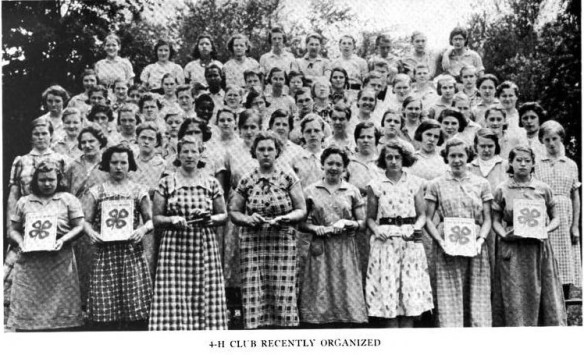Besides having state insane asylums for the mentally ill, New York State had other institutions for the “care and treatment of its mental defectives.” The medical records and places of anonymous burials of these people, many of whom were children, are unavailable to the public. They are: The Syracuse State Institution for Feeble-Minded Children, (New York Times – Syracuse Asylum), Syracuse, Onondaga County, NY, established in 1851; The New York State Custodial Asylum for Feeble-Minded Women, first opened in 1878 as a branch of the Syracuse State Institution for Feeble-Minded Children, but made an independent institution and located at Newark, Wayne County, NY in 1885; Craig Colony for Epileptics, Sonyea, Livingston County, NY, established in 1892; The Rome State Custodial Asylum, Rome, Oneida County, NY, opened May 1, 1894; Letchworth Village, for the care of feeble-minded and epileptic persons, Thiells, Rockland County, NY, established 1911.
The following excerpts and pictures were reprinted from The Annual Report Of The Board Of Managers Of The Rome State Custodial Asylum for the years 1907, 1908, and 1909.

1907 RSCA Inmates Glee Club
1907
FUTURE POLICY.
“We again recommend, as did we last year in our annual report, that arrangements be perfected as soon as possible for separating the sexes and removing all the females from this institution, leaving this a colony purely for males, and that we continue to develop our system of farm colonies for the brighter male inmates to the extent of establishing at least ten such farm colonies with 1,000 acres of land. With such extension of farm lands, we are very sure that we would be in a position to produce all the vegetables required for the maintenance of the asylum as well as all the milk and butter required for the institution.
We continue to feel the necessity, more than ever before, for a separate building for the care of the criminal class of feeble-minded, in which such criminal class may be separated from our general population and be taught trades, and receive the benefit which such continuous occupation will afford them, as well as the institution be benefited through the products of their labor in the manufacture of boots, shoes, clothing, brooms, mats, etc.” (26)

1907 TB Pavilion Exterior
ADMISSIONS.
“The number of admissions during the year, 261, is the largest number by more than 100 that has ever been admitted in any one year’s history of the institution.
The opening of the new ward building J for male inmates, on April 1, 1907, made possible the admission of this large number of cases during the year. Of the number admitted 233 were males and 28 females. It is interesting to note that of the total admissions nearly one-half were under 21 years of age and that 68 were between 16 and 21 years of age, 100 were between the ages of 5 and 16, and 5 below the age of 3. Here again is evidenced the fact that the cases are coming to us at younger ages than heretofore, and this is very desirable as it is during this younger age that most can be done for the feeble-minded, especially the custodial class, toward training them in habits of cleanliness, industry, domestic work, etc.
Of the number admitted during the past year an especially large percentage has been of the more feeble class, as paralytics, with quite a number of cases of tuberculosis, as a result of which we have had more tuberculosis in the institution during the past year than at any time in the previous history of the institution.
Of the admissions this year, 71 came from Greater New York, 61 from county homes, 60 from Syracuse school, 11 from orphan asylums, 9 from reform schools, and 48 direct from their homes.
This tendency of the reform schools indicated above, to transfer their defectives direct to this asylum, again makes it necessary for us to regard the need at this institution for a separate department for the care of the criminal class of feeble-minded separate from our general population. The importance of this can only be fully appreciated through constant daily association with the care of the custodial class of feeble-minded when associated with the criminal classes.

1907 TB Pavilion Interior
APPLICATIONS FOR ADMISSION.
We continue to receive, almost every day, applications for the admission of additional cases, and while we stated last year we had 500 applications on file, and during the past year we have admitted 261 cases, still the number of applications on file, for suitable cases for care and treatment here, is over 400, this 400 not including the more than 100 applications which we have received for the admission of epileptics, insane feeble-minded, etc.
However, in this connection, we are of the opinion that were all females to be removed from this asylum, thus creating accommodations here for an additional 300 male inmates in the buildings now occupied by female inmates, and were we to continue our plans for farm colonies for the brighter class of boys to the extent of about 20 per cent, of our population, we will be in a position to accommodate all the applications which we receive for male inmates and thus, when the repairs are completed which are under way at the present time, and the additional repairs contemplated as per our requests for next year of the Legislature, no additional buildings will be required in connection with the main asylum group of buildings for the care of additional cases, with the exception of the separate building of the criminal class as previously referred to.
DISCHARGES AND TRANSFERS.
There were seven males and three females discharged during the year. Of this number four boys were discharged because they were sufficiently improved that they could earn their living and care for themselves outside. Two other boys were discharged to the custody of their families, their parents feeling that they were sufficiently improved that they could be of assistance at home and were practically in a normal condition, and the remaining male was a paralytic and was taken home by his family for home care. Of the females, two were transferred to Newark Custodial Asylum and the other girl was discharged as having been sufficiently improved to be able to properly care for herself and earn her own living.
It continues to be our policy to refuse to discharge all females except as above noted, that is, that no feeble-minded female shall be returned to her family or allowed her freedom after having once been committed to our custody, except that the courts order same, as we believe it should be the policy of the State, after having these cases once committed to its care and custody, that they should retain them, for the protection of society in general and for the economic interests of the State, as well as for the protection of the individual, it having been our experience that when these cases are taken out they are sure to drift into immorality and crime and in the course of a short time application is made to us for their return to the institution, the individual having not only lost all benefit which he had derived from the care, training and treatment here, but also was in much worse condition, both physically and mentally, than when taken away from the institution.
DEATHS.
The death rate during the year was about 4 ½ per cent., there having been 46 deaths, of which number 34 were males and 12 females. The number of deaths from tuberculosis during the year was 10 males and 2 females, this being about the same number as during the preceding year and being about the same percentage of deaths from tuberculosis as the average for the preceding twelve years, that is, about one-third of the deaths is due directly to tuberculosis.
We have had during the year several isolated cases of typhoid fever. However, only one of these cases died and there has been no evidence of the condition spreading or becoming general in nature. The State Board of Health was called upon to assist us in ferreting out the source of infection if possible. However, as the cases were very isolated, no two occurring in one department of the institution and the cases were all confined to inmates, there seemed to be no one source of infection, and as our water supply, milk supply and food supply was free from infection no special importance was placed upon the fact that an occasional one or two isolated cases of typhoid existed in the institution.” (29-32)
ROME STATE CUSTODIAL ASYLUM TRAINING SCHOOL FOR ATTENDANTS FOR MEN AND WOMEN.
“For training attendants in the physical care of the feeble-minded and the physically infirm, and also in the manual, mental, moral and industrial training of the feeble-minded.
The Rome Custodial Asylum is entirely owned and maintained by the State of New York for the care and treatment of feeble-minded and idiotic persons, the following classes being cared for: All of both sexes below the age of seven; all of both sexes between the ages of seven and fourteen who are physically infirm (the ablebodied feeble-minded children who can use language between the ages of seven and fourteen are sent to the Syracuse School for feeble-minded), and cases past the age of fourteen, both sexes, with no further age limit.
The asylum, with its population of 750 (soon to be 1,000) cases, cares for many children, many physically infirm, as cripples, paralytics and bedridden cases, many of the feeble-minded juvenile delinquent class and many adults, among which are a considerable number of the State reformatory classes.
The course of training shall cover two years, of fifty-two weeks each. The first shall be devoted to the training of attendants in all that pertains to the physical care of the physically infirm and mentally enfeebled, and the second year shall be devoted to the training of attendants in the physical, mental, moral and industrial training of the feeble-minded.
For entrance to the school, the applicant shall be twenty-one years of age, and come recommended by two responsible persons who have known the applicant for at least two years, in addition to which the applicant shall file an application, the statements in which are to be sworn to as follows: . . .” (61)
This job paid $20.00 per month for males; $16.00 for females. The hours were: 6:15 AM to 6:00 PM and 6:15 AM to 7:30 PM, on alternating days with one hour off duty every afternoon.
SOURCE: Thirteenth Annual Report Of The Board Of Managers Of The Rome State Custodial Asylum At Rome, N.Y., For The Year Ending September 30, 1907, Adopted At Annual Meeting December 2, 1907, Transmitted To The Legislature February 12, 1908, Albany, J.B. Lyon Company, State Printers, 1908, Pages 26, 29-32, 61.

1908 The American Association for the Study of the Feeble-Minded. In Session at the Asylum June 22 – 25, 1908

1908-2 Employees Building

1908-3 Bailey Farm Colony

1908-4 Ward D-3

1908-5 Ward E-12

1908-6 Inmates Orchestra

1908-7 Exhibition Of Fancy Work
1909
SEPARATION OF SEXES.
“The separation of the sexes is one of the greatest, if not the greatest, move that can be made in the direction of economy in management of this asylum, both from the standpoint of a reduced per capita cost of maintenance as well as the betterment of the service. Such separation will allow the inmates the whole freedom of the buildings and grounds, and thus they will require much less supervision when at work or at play to keep them from encroaching on the grounds occupied by the opposite sex, (no fence or partition can prevent the passing of notes or conversation which leads to secret meetings and planned escapes).

1909-8 Brush Farm Colony
Such freedom for the inmates allows of their greater usefulness in doing errands, also in being left to work alone at tasks which they can well do with no supervision. And, too, this freedom from constant supervision, thus throwing the inmate on his own resources and calling into play his own judgment, better qualifies him for the next task, as I have had many opportunities of observing (notwithstanding the overdrawn observation frequently stated that the feeble-minded have no judgment. True, they apparently have none when they are never allowed to use it, and they will continue to show none so long as some supervisor continues to constantly judge for them).

1909-9 Bailey Farm Colony
Some one may suggest that the damage to property and morals resulting from lack of constant supervision will more than offset any saving that may result in salaries, but to this I say we seldom see a feeble-minded boy when given a suitable task become destructive or meddlesome, even if he is not closely supervised, and I daily see boys at the farm colonies left in the fields to plow, harrow, plant, hoe, etc., with the farmer only occasionally calling around to direct and supervise, and it is seldom indeed that such boys do damage or injury.

1909-10 Inmates Band
Amusements and entertainments have been continued during the year as usual, and all this is made possible through the liberal response received to our annual holiday appeal to relatives and friends of inmates. Such funds have allowed us to place pianos on all the wards and to furnish a liberal supply of music for the band and orchestra as well as an occasional new musical instrument, as mandolins, guitars, horns, violins, etc., for the use of the patients, and I take this opportunity of thanking in behalf of the inmates all who have thus showed their especial interest in the asylum and its work.
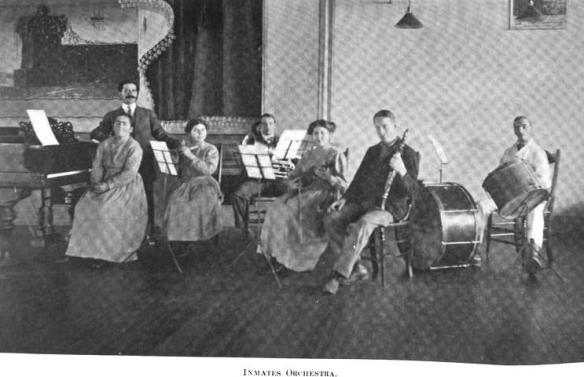
1909-11 Inmates Orchestra
I wish to again express my appreciation of the loyal support accorded me by my associate officers and employees, and to most sincerely thank the members of the Board for their continued interest and devotion to the uplift of humanity as exemplified in the work of this asylum.
Respectfully,
CHARLES BERNSTEIN, Superintendent.” (26-28)
SOURCE: Fifteenth Annual Report Of The Board Of Managers Of The Rome State Custodial Asylum At Rome, N.Y., For The Year Ending September 30, 1909, Adopted At Annual Meeting December 6, 1909, Transmitted To The Legislature January 12, 1910, Albany, J.B. Lyon Company, State Printers, 1910, Pages 26-28.

1909-12 Inmates Choir
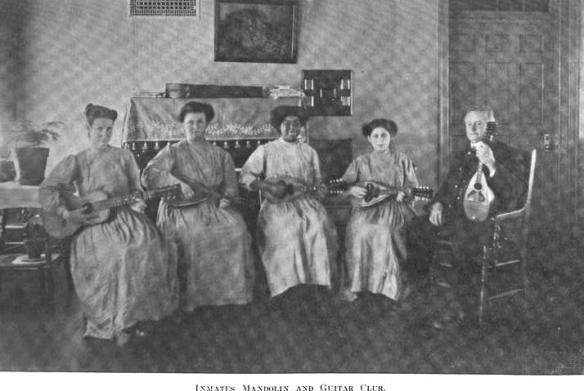
1909-13 Inmates Mandolin and Guitar Club

1909-14 Boys Kindergarten
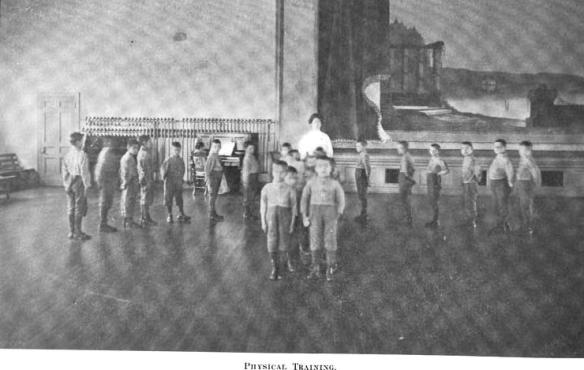
1909-15 Physical Training

1909-16 Calisthenics

1909-17 Babies Kindergarten

1909-18 Primary School Work

1909-19 Grammar School Work
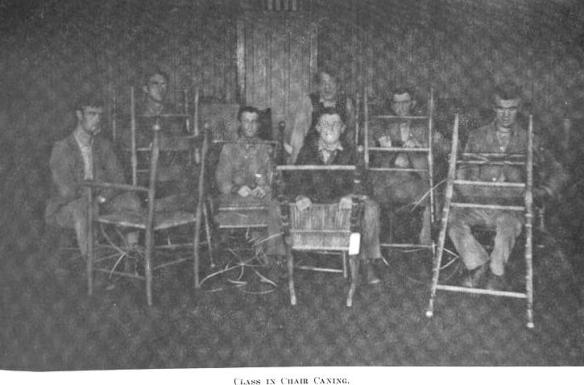
1909-20 Class In Chair Caning

1909-21 Primary Sewing
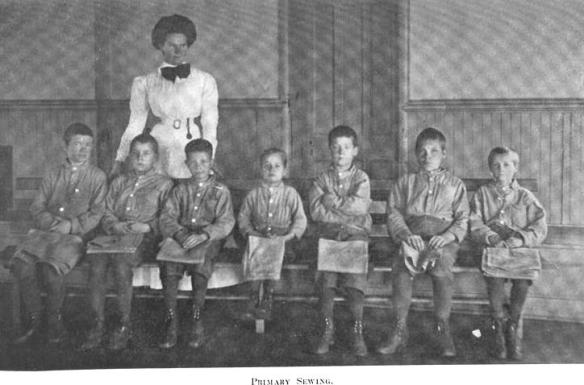
1909-22 Primary Sewing

1909-23 Sewing Class
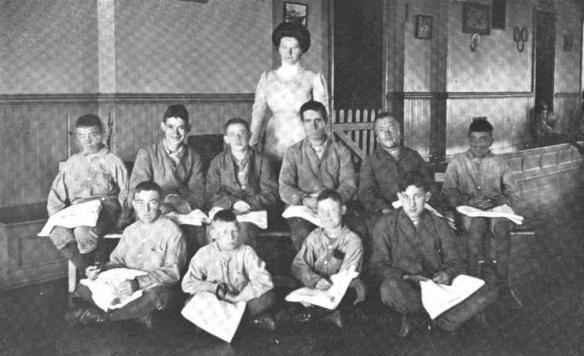
1909-24 Sewing Class

1909-25 Class In Ironing
Photographs:
SOURCE: Thirteenth Annual Report Of The Board Of Managers Of The Rome State Custodial Asylum At Rome, N.Y., For The Year Ending September 30, 1907, Adopted At Annual Meeting December 2, 1907, Transmitted To The Legislature February 12, 1908, Albany, J.B. Lyon Company, State Printers, 1908.
SOURCE: Fourteenth Annual Report Of The Board Of Managers Of The Rome State Custodial Asylum At Rome, N.Y., For The Year Ending September 30, 1908, Adopted At Annual Meeting December 7, 1908, Transmitted To The Legislature March 2, 1909, Albany, J.B. Lyon Company, State Printers, 1909.
SOURCE: Fifteenth Annual Report Of The Board Of Managers Of The Rome State Custodial Asylum At Rome, N.Y., For The Year Ending September 30, 1909, Adopted At Annual Meeting December 6, 1909, Transmitted To The Legislature January 12, 1910, Albany, J.B. Lyon Company, State Printers, 1910.
Museum Of disABILITY great resource!



